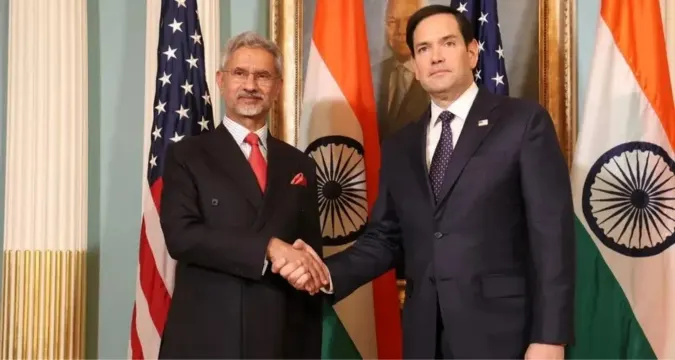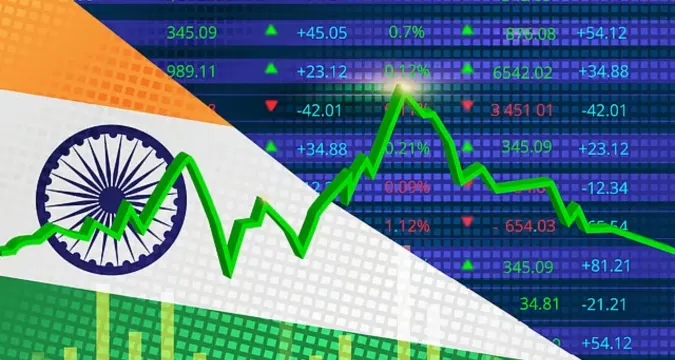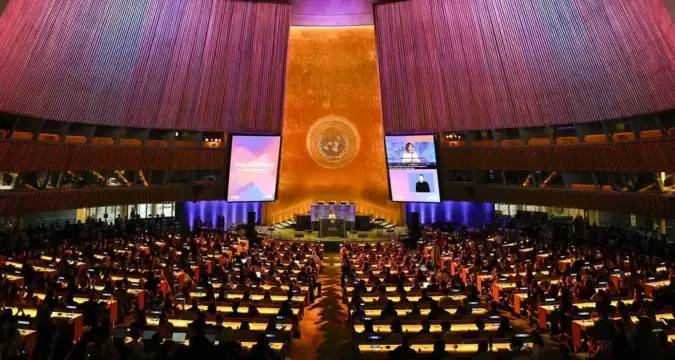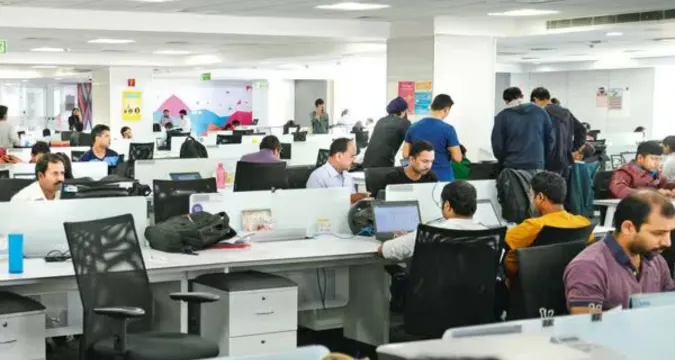EAM Jaishankar Meets US Secretary Marco Rubio in New York Amid $100,000 H-1B Visa Fee Row
New York, India and the United States are in a touchy diplomatic deadlock again. Just as the External Affairs Minister Dr. S. Jaishankar (EAM Jaishanker) is about to meet US Secretary of State Marco Rubio in the sidelines of the United Nations General Assembly (UNGA) today, the limelight is squarely on one topic and one that would have direct impact on millions of visa-seeking families and businesses on either side: The H-1B Visa Hike.

It has not only sent shockwaves through the Indian IT firms, but the Trump administration announcement of a $100,000 fee to use H-1B visas has brought about panic amongst the Indian professionals who view H-1B as the door opening to the forward looking American competitive economy. This talks process is doublayed by Amila, as bilateral relations are not founded on trade tariffs and energy policies which are also strained this time making this conversation between Jaishankar and Rubio more than just a standard conversation.
A Meeting of Consequence at UNGA
Jaishankar and Rubio will both have their meeting at 11 AM (local time), New York (8.30 PM IST) according to the official schedule given by the US State Department. Meetings between the foreign ministers of both the Indians and US are not entirely considered as strange, however, the timing of this particular meeting is very important.
This will be his third face-to-face encounter with Jaishankar and Rubio this year. This was their second meeting in January and in July when Quad Foreign Ministers figured in Washington, DC. Their first interaction, however, is the first one in years following two severe blows to bilateral relations:
- The half tariff increase that Washington had reduced on Indian products in late August.
- In mid September Trump proposed an increase in H-1B visa fee.
The two issues have a direct economic effect on India, and it is the reason why the current dialogue is important to alleviate tensions.
Why the H-1B Visa Matters So Much to India
H-1B visa is a non immigrant type of visa granting the US companies the option to hire skilled foreign workers in the areas of IT, engineering, medicine and research. Over the past few decades, it has been the genesis of Indian talent migration to the United States.
- The majority of all the H-1B visas are usually awarded to the Indian nationals (70%).
- Every year, approximately regional, more than 85, 000 new visas are shot through and the Indians have remained to be the highest in the applications.
- TCS, Infosys, Wipro, HCL, Tech Mahindra and multinationals like Google, Meta and Microsoft require the talent of H-1B.
It should be the contribution of a tsunami to impose an increase of fee of $100,000 (which is approx 90 lakh) per petition. In the case of big companies money into millions of dollars is spent. In the case of smaller companies, the new charge may be predatory and they may be forced out of the US market.

The white house made it clear that the charge is not a yearly charge, but a fee applied on each petition that will be submitted; extra charges will not be spent on those who have been issued a visa and are reentering the US. Nevertheless, the message is now clear that Washington access is restricting the dependency on foreign labor and transferring the responsibility of costs to employers.
Trade and Tariffs: A Parallel Battle
The ok visa rate is not the sole prick in the India-US collaboration. The trade conflict has again become dynamic because July when Trump restored high tariffs on Indian products. Indian exporters of textile goods, engineering goods, pharmaceutical goods and steel are directly impacted when it comes to the move as most of them were only coming out of the global supply chain upheaval.
At the same time Union Commerce Minister Piyush Goyal is in Washington leading a parallel round of negotiations. As it has been reported, India is working to have relief on tariffs besides pursuing greater market accessibility to the Indian sectors such as IT services, pharmaceuticals, and agriculture.
Trump, in his turn, says that the tariffs and the visa free fees are elements of his economic program in the United States first, as it will ensure a decrease in trade deficits and preserve jobs domestically. Critics however state that the actions tend to frustrate the relationship with India when Washington is in need of power alliances in the Indo-Pacific.
Diplomatic Sensitivities and Strategic Interests
It is not that the encounter between Jaishankar and Rubio is just economical. It enters into a situation of several geopolitical challenges:
- Acquiring Russian oil through Western sanctions still provokes India.
- Quad alliance or the one of such alliances between India, the US, Japan and Australia is under strain to provide realistic output in terms of combining efforts in maritime security and technology.
- Even the UNGA session is a high-stakes arena and the arguments have covered climate action to global peacekeeping.
It is delicate diplomacy on the part of Jaishankar to balance the hedging we can be autonomous as a nation and yet have good relations with Washington at the same time. It is subtle enough as well that in the case of Rubio ensuring to both support his stances regarding the policies of Trump and to continue to engage India as a partner.
Indian IT Industry’s Fear and Frustration
One of the largest stakeholders of this controversy is the Indian IT industry, about to pay close to 8% of Indian GDP, provided it employs more than 4.5 million people.
- Several industry associations such as NASScom have cautioned that this could greatly ding the competitiveness with the increase in fees.
- Infosys and Wipro executives claim privately that the cost will either be covered in employees or imposed on customers which will reduce the profit margin.
- Major IT companies and startups are even afraid to be bid off the market in the US altogether.
Even the Indian professionals worry. Numerous potential H-1B customers take years of schooling and financial training in search of an American job. The $100,000 price puts a sizable lockout barrier to them, and the Silicon Valley position is seen as even more distant.
US Domestic Politics Behind the Move
The economic influence of the Trump administration decision is not that simple. Analysts define it as a domestic political strategy prior to elections of 2025.

- Through the increase in visa charges, Trump wins the favour of the working-class, which feels that foreign workers deprive Americans of their employment.
- The relocation is a lesson to the companies, as well: employing more Americans or it costs even more to import foreigners.
- Critics in the US are claiming that this protectionist strategy will boomerang against America where although the country may fight to secure the best talents in the world it may not be able to do so.
It is already of concern to some American universities and research institutes that restrictive visa regulations may put the US in the lead in terms of innovation.
Reactions in India and Abroad
The announcement has not caused less of a stir among the members:
- Indian government: The move has been termed as discrimination by the officials and it negatively affected the spirit of cooperation between India and the US.
- Technological giants: Meta and Microsoft have reportedly sent emails to Washington on the understanding that its continued projects will be disrupted.
- Indian professionals: The anxiety as well as anger has reached the social media with many questioning the fact of whether the US is an effective place to pursue a skilled talent.
Meanwhile, growth increase has been embraced by some US labour groups claiming that it will make the playing field equal to the domestic workers.
What Could Happen Next?
There are a variety of outcomes which the Jaishankar-Rubio talks we have today can produce:
- Guarantees, rather than rescissions: Washington can give exemptions or give more mutability it is unlikely that the $100,000 fee will be completely eliminated any time soon.
- Association with the trade agreement: India can make tariffs and visa charges concessions as a subset to a larger trade agreement.
- Long term adjustments: India will trigger this reaction by providing incentive to US-based companies to increase their activities in India, and this crisis has become an opportunity to create jobs within the country.
The Bigger Picture: People-to-People Ties
The H-1B visa scandal highlights something bigger: the importance of people to people relationship in diplomacy. Indian talent has played the central role in the technology-driven economy of America for decades. The Indian-American population in the US is close to 4 million with many having entered the country originally on student or work visa.

The US may end up undermining such a bond by rendering the course more costly. In the case of India, as well, there is the hurdle of keeping its top talents available all over the world even though the US will become less hostile.
Conclusion
Today, Jaishankar and Rubio can sit down in New York and the stakes are high. This cannot be merely another diplomatic endeavor as it will be an enactment of strength in the India-US partnership.
In the case of India, the fee increase is a direct impact to the IT industry, and professionals of India. In the case of the US, it is a political action that is aimed at pleasing the domestic front but one with international repercussions. Both parties understand that their strategic relations are vital yet the path will be long and painful.
Regardless of whether the current discourse brings about hard-earned breakthroughs or merely more time to buy, there is one thing, which is H-1B visa fee increase has already become the code word in relation to the inadequacy of balancing national politics and the possibility of international collaboration.
The success of the Indian professional does not only depend on the overall cost of a visa, but also on the future of their dream in America.
For more updates on India–US trade talks, follow our Latest News section.








